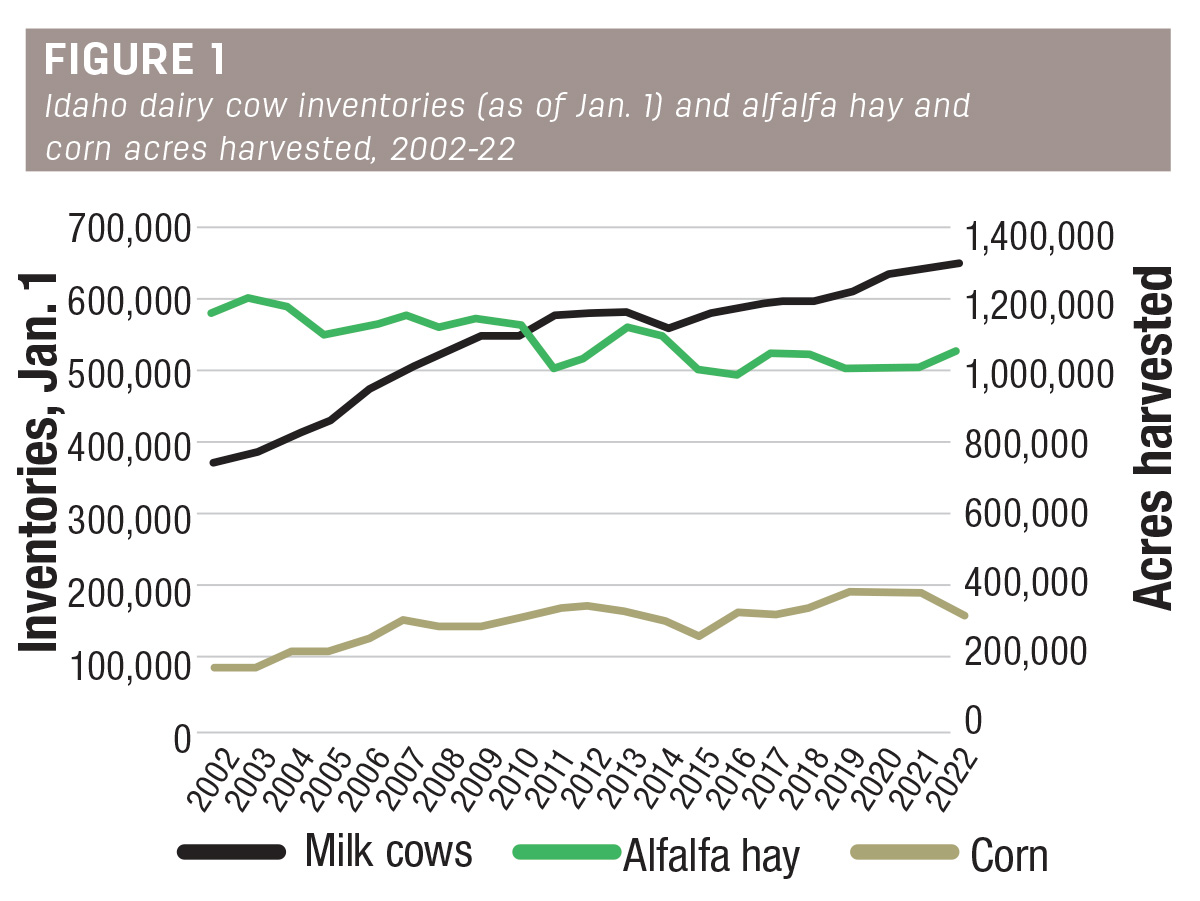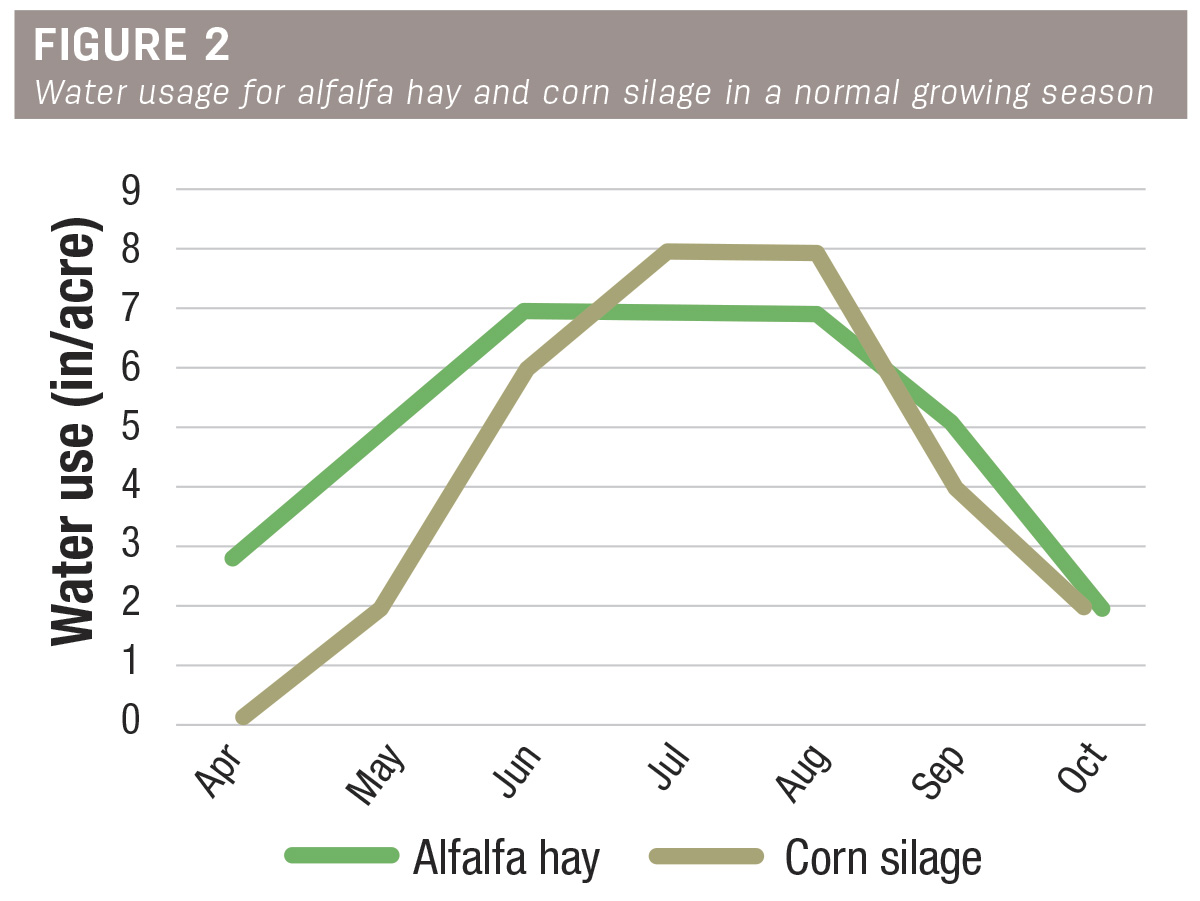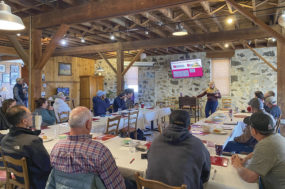The expansion of the dairy industry in southern Idaho over the past few decades has had substantial impacts on the broader Idaho agricultural economy, including the allocation of crop acreage. This article describes the changes in crop acreage and dairy rations for key feed crops, alfalfa hay and corn between 2002-22 and then provides estimates of the water demand implications from these shifts.
Figure 1 includes a plot of Idaho milk cow inventories (as of Jan. 1) and acres harvested of alfalfa hay and corn (total of both grain and silage) from 2002-22. It observed that milk cow inventories have increased from just under 400,000 in 2002 to over 650,000 in 2022. Additionally, alfalfa hay acreage harvested has declined from an average of about 1.15 million acres harvested annually between 2002-06 to an average of 1.03 million acres harvested per year between 2018-22. Correspondingly, corn acres harvested increased from just under 200,000 acres harvested in 2002 to consistently over 350,000 acres harvested since 2018. The main messages of Figure 1 are that, since 2002, milk cow inventories and corn acres have steadily increased, and alfalfa hay acres have steadily decreased.

There has been an associated shift in dairy cow feed rations that has occurred at the same time as the changes in crop acreage. Specifically, my University of Idaho (UI) extension specialist colleagues in dairy estimated that the amount of alfalfa hay included in dairy cow rations has declined from over 18 pounds per day between 2003-06 to about 7 pounds per day between 2017-21. Additionally, for these same periods, corn silage amounts included in dairy rations increased from about 27 pounds per day to 53 pounds per day. Thus, the increased production of corn in Idaho is being used to a large degree by including more corn silage in dairy feed rations.
What are the implications for water use?
To answer this question, I utilized data from the U.S. Geological Survey (USGS) on overall usage of water in Idaho and UI extension reports on the water requirements for growing alfalfa hay and corn. The USGS data show that, as of 2015, irrigation accounted for 86.2% of total water usage in Idaho. The other usages and their associated percentages were aquaculture (11.1%), public supply (1.6%), domestic (0.4%), livestock (0.3%), industrial (0.3%), mining (0.1%) and thermoelectric power (less than 0.1%).
The water requirements for alfalfa hay and corn silage over the course of a normal growing season, per UI extension reports, are plotted in Figure 2. The total water use over the full growing season by alfalfa hay is 36 inches per acre, while that for corn silage is 30 inches per acre. So, corn silage requires less water than alfalfa hay. However, the distribution regarding the timing of the demand is different for the two crops. Alfalfa hay uses water earlier in the growing season and more uniformly across the growing season than does corn silage. Additionally, water usage for corn silage peaks in July and August at a level of 8 inches per acre, which is higher than the peak usage by alfalfa hay.

To estimate the water usage implications from both the increasing inventory of dairy cows and the shift in acreage toward less alfalfa hay and more corn acreage, I made the following calculations. First, I estimated the annual acre feet of water used by all alfalfa hay and corn acreage for the five-year periods of 2002-06 and 2018-22. To do this, I multiplied the average number of acres harvested for alfalfa hay and corn by their water usage in acre-feet. I then subtracted the values associated with the 2002-06 period from those of the 2018-22 period to obtain an estimate of “total water use change” for each crop.
The results from these estimates showed a decline in 384,000 acre-feet of water used for alfalfa hay and a 362,500 increase in acre-feet of water used for corn. This implies that a net decline of 21,500 acre-feet of water was used for irrigation due to the shift to fewer alfalfa hay acres and more corn acres.
The next step was to account for the increased usage of water for livestock due to the increase in milk cow inventories. Based on the USGS water use data, water use annually for livestock, as of 2015, was 57,000 acre-feet. So, I multiplied this value by the percentage change in dairy cow inventories between 2015 and 2022, which was 12.6%. The result was a water use estimate for livestock as of 2022 of 64,200 acre-feet. This corresponds with an increase of about 7,200 acre-feet in water used for livestock.
The last step was to sum up the implied reduction in water use resulting from the acreage shifts toward less alfalfa hay acres and more corn acres (-21,500 acre-feet) and the increase in water use due to more livestock (+7,200 acre-feet). The result is a net water use reduction of about 14,300 acre-feet. This implies a net decrease of about 0.07% of total water usage in Idaho based on 2015 levels.
There are a couple of main takeaway messages from this article. First, the growth in the dairy industry in southern Idaho since the early 2000s has corresponded with a shift in acreage toward fewer alfalfa hay acres and more corn acres. The net effects of total water usage resulting from these changes, and accounting for the increased number of dairy cows, are less than 1% of total water usage. However, the timing of water demand is also impacted by these changes, such that less water is needed in the early part of the growing season (April and May), while more is needed in July and August. These shifts may likely cause changes in the water flow levels in the Snake River and canals and may influence year-to-year carryover volumes and variability.
References omitted but are available upon request by sending an email to the editor.


.jpg?t=1687979285&width=640)




